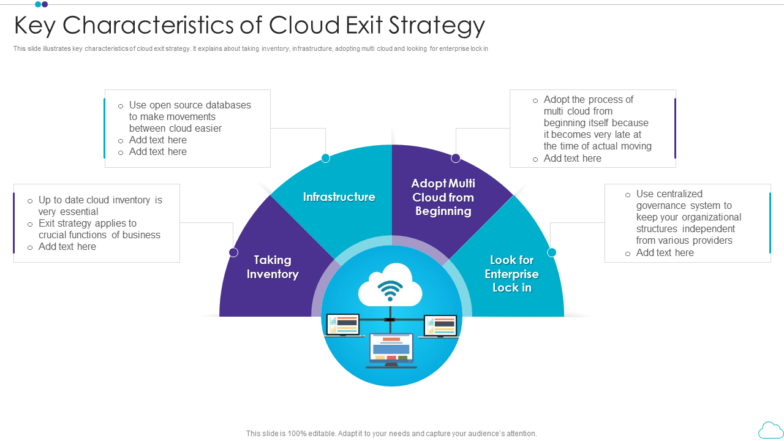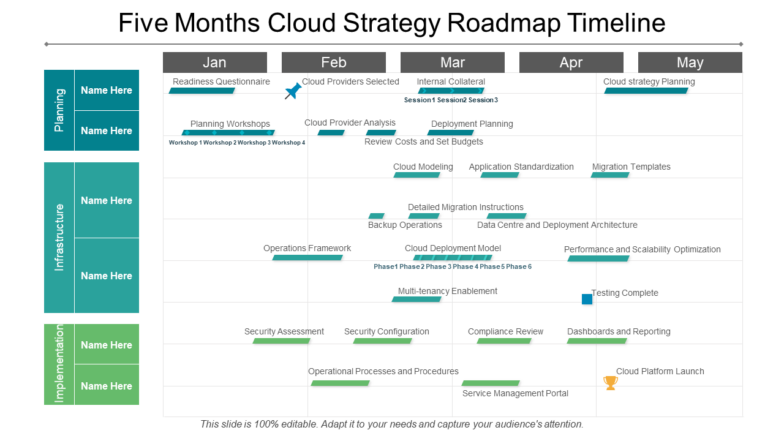

![]()
0 Comment
Customer Reviews (0)Businesses, globally, are embracing the cloud’s transformational nature, recognizing the impact it has on performance, agility, and security.
By 2024-end, close to a third of new software investments that technology providers make will have shifted from cloud-first to cloud-only. IT teams are attempting to embrace cloud applications and relocate existing digital assets as organizations’ reliance on cloud technologies grows.
The C-suite will look to the CIO to answer cloud-related questions and define a strategy for cloud integration in the enterprise. The CIO, on their part, often delegates this task to an enterprise architect and/or chief technology officer.
A cloud strategy is an outline for a company’s use of the cloud as a business asset and is not a plan to move everything to the cloud.
Most organizations do not have a formal cloud strategy in place today, but by 2024, 80% will see value in formalizing a policy governing the use of the cloud. Businesses that have such a plan take a more unified approach to cloud computing, optimizing resources and costs.
IT leaders can use a ‘cookbook approach to developing a cloud strategy. It will ensure that cloud decisions align with corporate goals and account for decisive elements and potential risks, guaranteeing C-suite buy-in.
Mapping this strategy back to existing implementation and migration plans will aid in a successful transition to the cloud.
CIOs should focus their efforts on developing a living document that will be updated in line with the organization’s digital assets and goals.
Here’s the ‘cookbook’ — ten cloud strategy templates IT leaders can take to develop a comprehensive, actionable cloud strategy that meets business needs:
The importance of cloud strategy for an organization can’t be overstated. With this illustrative PPT Template, you get the following:
Don’t wait for this peerless resource to get into the hands of your competitors. Download this template now.

When you have a cloud strategy in place, you need a roadmap to ensure everything is on the right track. This predesigned PPT Template lays the groundwork for you to develop an inclusive five-year roadmap that complements your cloud security strategy. Get it now!

Building a robust cloud strategy necessitates careful planning, supplemented by the right information and resources. SlideTeam believes you have what it takes to structure a workable plan, and we have taken care of the intel and resources part. Here’s an exemplary PPT Template that keeps you from losing sleep over building a cloud strategy. Get it now!

Preparing a business planning framework for cloud strategy is a hard nut to crack. Our well-designed PPT Template makes it easy. Its design breaks down the framework into five understandable stages: Startup, Discovery, Analysis & Assessment, Recommendations, and Focus Areas. It ferrets out every minute detail that can affect your cloud strategy. Download it now.

You wouldn’t believe anyone who says, “Your cloud optimization strategy can be structured in five steps.” It’s a subject far too complex to be boxed into countable stages. With SlideTeam’s predesigned PowerPoint Template, you can build an inclusive cloud optimization strategy that supports your business goals. Use this template to end with the optimization of all your cloud processes. Get it now.

If building a cloud data migration strategy is giving you sleepless nights, you have reached the solution you seek to ease your burden. With the download of this content-ready PPT Template, you get the following:

Having a cloud strategy in place has numerous benefits. This ready-to-present PPT Design showcases the five critical advantages of that long list. Use this presentation template to motivate your team to start developing a cloud strategy and enhance ROI, increase digital security, and decrease the risk of disaster and latency. Grab it today!

Implementing and managing a cloud strategy is not as simple as shifting from brick-and-mortar to digital stores. It is an iterative and dynamic process that needs continuous monitoring. This template will help you present and design the cloud strategy process in three phases and ensures you get buy-in on what you are doing. Get it now!

A true businessman enters a business or strategy only after deciding on an exit plan if, in case, things do not pan out as expected. Cloud storage is undoubtedly complex, and if not handled with care, it may cost you a fortune. This predesigned template will help you and the top management understand, describe, and prepare a cloud exit strategy.

If you are investing your time and resources — money, tools, and workforce — into a strategy, you want to plan it for at least one-quarter of the year. This template will help you build a detailed five-month roadmap for your cloud strategy. With this template, you can plan activity for each month and all three phases — implementation, infrastructure, and planning — of cloud strategy. Grab this PPT Design now!

These fantastic templates cover the cloud’s benefits, potential risks, a basic understanding of technologies, and the steps you and your team must take to develop your cloud strategy. You now have the necessary skills to begin developing your cloud strategy.
The three-step process to Build a Cloud Strategy entails the following:
Step 1: Rehost/ Lift and Shift
Most traditional businesses begin their journey to the cloud by lifting and rehosting what they have in their data center in the cloud. Lift and shift is the most expensive method of migrating data to the cloud, but it is also the quickest.
A word of caution: Do not attempt to maintain a product with one leg in your data center and the other in the cloud. Operating in two worlds can be stressful, unstable, and challenging. As a result, select a cloud service provider and commit to the cloud fully and for the long term.
Step 2: Iterate Rapidly
Focus on iteration after you've moved your applications to the cloud. Examine the costs associated with operating your system and determine which features, products, or unit costs are the most expensive for system operation. Why? Because what was cheap in the data center may not be affordable in the cloud, even if there are less expensive alternatives. You can use managed services from your cloud provider. However, you should not base iteration and development work on the cost of bringing your products and features to the market.
Step 3: Adopt a Philosophy of Flexibility and Elasticity
As you transition to the cloud, your team will begin to consider managed services and cloud services that they can leverage/use to move faster than they could when the company was on-premise.
Next, please adopt an elasticity and flexibility philosophy for rapid change. At this point, your systems and the costs associated with these should scale up and down dynamically based on customer load.
The closer you get to a curve where your customer activity matches your system activity, which fits your costs, the better you'll be able to see an accurate indication of how efficiently your systems are running.
A cloud strategy team defines the motivations for cloud adoption as well as the business outcomes. They then validate and keep business priorities and cloud adoption efforts in sync. Your company should develop a strategy that clearly connects technical activities to business outcomes.
The four principal cloud computing types are as follows:
There are three kinds of cloud computing services:
Each of these comes with unique advantages and disadvantages. Use the one that meets most of your specific objectives. Any permutation or combination could also be used to fit your roadmap.
In its most basic form, a cloud-first strategy means prioritizing cloud-based solutions over on-premises solutions. Rather than building your own tech stack, you can subscribe to a service provider that provides cloud-based software or platforms. Rather than relying on in-house operations, your organization uses the service provider’s infrastructure and, as a result, receives high-quality services.
Although not all your infrastructure must be hosted in the cloud, new additions to your tech stack should be hosted in the cloud whenever possible. You should also consider which of your on-premise solutions should be moved to the cloud to improve efficiency.
To meet your requirements, most organizations will use a combination of Platform as a Service (PaaS), Infrastructure as a Service (IaaS), and Software as a Service (SaaS).